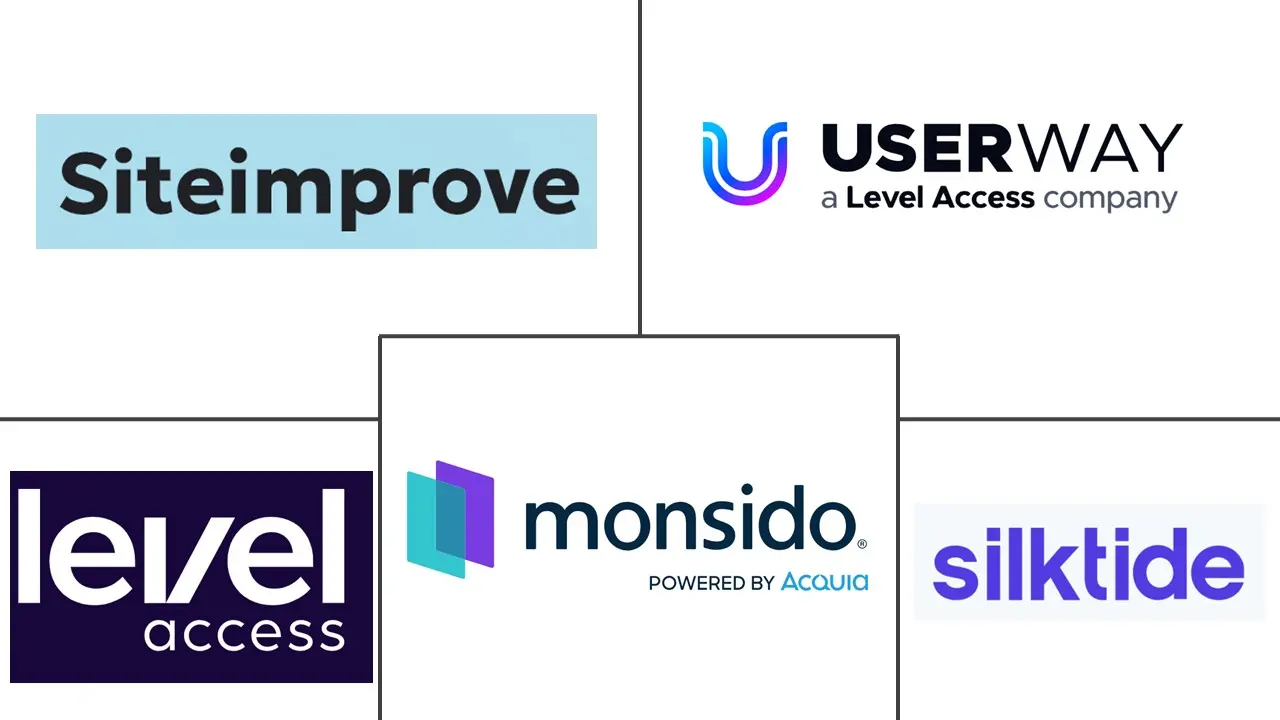Digital Accessibility Software Market Size and Share
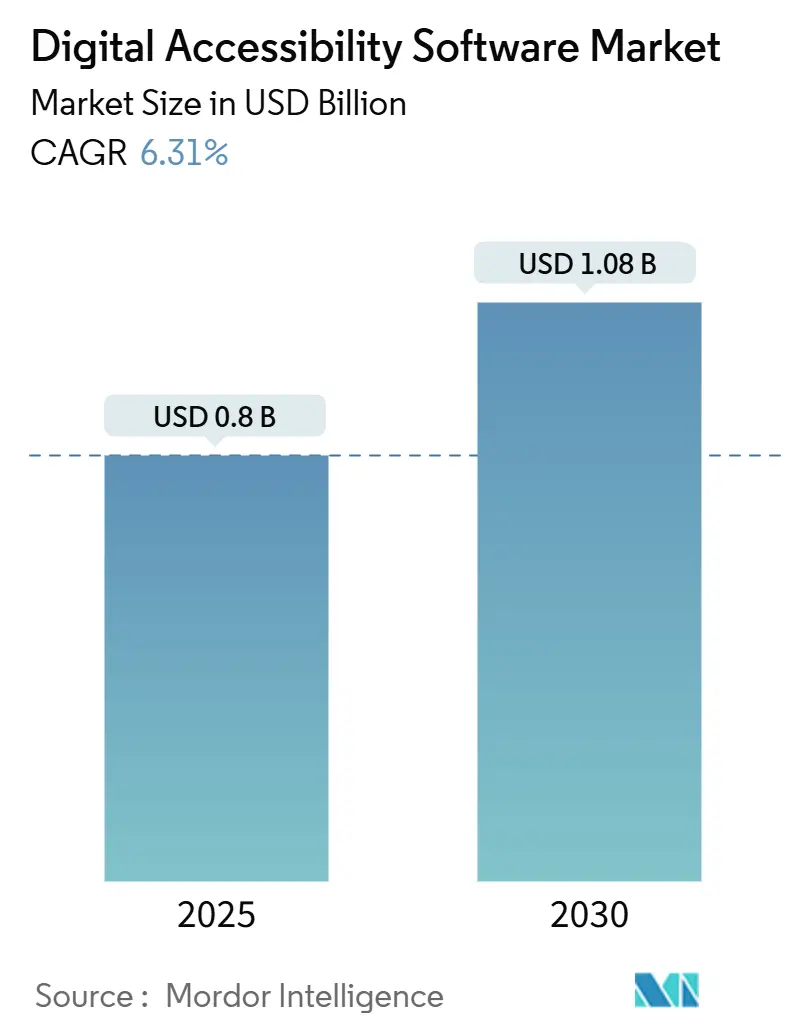
Digital Accessibility Software Market Analysis by Mordor Intelligence
The digital accessibility software market size stands at USD 0.80 billion in 2025 and is projected to reach USD 1.08 billion by 2030, registering a 6.31% CAGR over the forecast period. The current growth momentum mirrors three powerful forces: stricter global regulations, rapid AI-driven product innovation, and board-level ESG goals that elevate digital inclusion to a risk-management priority. Enterprises are reacting to the incoming WCAG 3.0 framework and the European Accessibility Act by expanding compliance budgets, while government agencies accelerate Section 508 and EN 301 549 enforcement through updated procurement rules. Vendors that embed high-accuracy machine-learning models into low-code SaaS platforms now deliver remediation at scale, shifting the cost–benefit equation and drawing small and medium enterprises (SMEs) into the addressable pool. Simultaneously, the ecosystem is consolidating as platform suppliers acquire point-solution specialists to build end-to-end offerings that span web, mobile, document, and video channels. North America retains leadership, yet Asia-Pacific’s double-digit expansion signals diversified geographic opportunity.
Key Report Takeaways
- By type, Website Accessibility Platforms held 47.2% of the digital accessibility software market share in 2024. Video and Captioning Assist Tools are forecast to expand at a 14.80% CAGR through 2030, the fastest pace among product categories.
- By deployment mode, cloud-based solutions accounted for 54.7% of the digital accessibility software market size in 2024 and are advancing at a 13.90% CAGR to 2030.
- By organization size, large enterprises commanded 61.8% revenue share in 2024, whereas SMEs posted the highest projected CAGR at 12.60% through 2030.
- By end-user industry, the Government and Public Sector led with a 29.5% share of the digital accessibility software market size in 2024, while the Media and Entertainment industry records the strongest growth at 12.20% CAGR.
- By geography, North America captured 44.98% revenue in 2024; Asia-Pacific is set to grow the fastest at 11.90% CAGR.
Global Digital Accessibility Software Market Trends and Insights
Drivers Impact Analysis
| Driver | (~) % Impact on CAGR Forecast | Geographic Relevance | Impact Timeline |
|---|---|---|---|
| Rapid adoption of WCAG 2.2 and impending WCAG 3.0 standards | +1.8% | North America and the EU first movers, global ripple | Medium term (2-4 years) |
| Proliferation of low-code/no-code SaaS tools lowering buyer TCO | +1.5% | North America and Asia-Pacific | Short term (≤ 2 years) |
| Government procurement rules mandating Section 508 and EN 301 549 compliance | +1.2% | North America and the EU | Long term (≥ 4 years) |
| AI-driven automated remediation accuracy surpassing 90% | +1.1% | Global, led by U.S. vendors | Medium term (2-4 years) |
| Digital-first customer-experience KPIs added to ESG scorecards | +0.7% | North America and the EU | Long term (≥ 4 years) |
| Expansion of streaming services requiring accessible video experiences | +0.6% | Global | Short term (≤ 2 years) |
| Source: Mordor Intelligence | |||
Rapid adoption of WCAG 2.2 and impending WCAG 3.0 standards
WCAG 2.2 adds nine success criteria with heavy emphasis on mobile usability and cognitive accessibility, while the forthcoming WCAG 3.0 shifts toward outcome-based testing. This evolution demands continuous monitoring platforms instead of periodic audits and has induced multinational firms to adopt integrated solutions capable of reporting across jurisdictions. Harmonization between EN 301 549 and WCAG 2.2 in Europe creates a regulatory domino effect, encouraging organizations to standardize on higher compliance baselines worldwide. [1]European Commission, “Web Accessibility Directive—Standards and Harmonisation,” DIGITAL-STRATEGY.EC.EUROPA.EU
Proliferation of low-code/no-code SaaS tools is lowering buyer TCO
Cloud-native providers now embed drag-and-drop remediation widgets and API-first testing into subscription packages, eliminating the need for dedicated accessibility engineers. The economic appeal resonates with SMEs that could not previously justify six-figure audit projects. E-commerce platforms integrating native accessibility, such as Shopify, demonstrate how accessibility is becoming a default feature rather than a premium add-on, broadening the revenue base.
Government procurement rules mandating Section 508 and EN 301 549 compliance
Revised U.S. procurement policies require accessibility conformance reports for every ICT purchase, effectively turning compliance into a prerequisite for public-sector business. Similar clauses in Europe force vendors to embed accessibility checkpoints in product roadmaps. These policies extend beyond agencies to contractors, amplifying market pull as suppliers future-proof bids.
AI-driven automated remediation accuracy surpassing 90%
Machine-learning models trained on large annotated datasets now detect context-dependent errors, cut false positives, and auto-generate alt-text with natural-language quality. Deque Systems’ axe platform illustrates how accuracy gains transform the ROI calculus by shifting man-hours from manual fixes to strategic UX enhancements.
Restraint Impact Analysis
| Restraint | (~) % Impact on CAGR Forecast | Geographic Relevance | Impact Timeline |
|---|---|---|---|
| Absence of globally unified enforcement and penalty mechanisms | -1.3% | Emerging markets, multi-region firms | Long term (≥ 4 years) |
| High false-positive rate of legacy testing engines | -0.9% | Global incumbents | Medium term (2-4 years) |
| Shortage of certified accessibility auditors and consultants | -0.8% | Asia-Pacific and developing regions | Long term (≥ 4 years) |
| Corporate “overlay-fatigue” backlash among disability advocates | -0.6% | North America and EU | Short term (≤ 2 years) |
| Source: Mordor Intelligence | |||
Absence of globally unified enforcement and penalty mechanisms
While the ADA, the European Accessibility Act, and regional laws exist, disparate penalty structures let non-U.S. or non-EU organizations pursue only minimal compliance. Multinationals juggle conflicting deadlines and reporting formats, dampening capital allocation toward comprehensive solutions and reducing revenue visibility for vendors. [2]Level Access, “Is WCAG Conformance Enough for EAA Compliance?” LEVELACCESS.COM
High false-positive rate of legacy testing engines
Older rule-based scanners often flag hundreds of non-issues in single-page apps, exhausting developer time and eroding faith in automation. The resulting “alert fatigue” pushes enterprises either toward premium AI platforms or back to manual audits, trimming the mid-market opportunity.
Segment Analysis
By Type: Platforms Drive Integration Demand
Integrated Website Accessibility Platforms generated USD 0.38 billion, equal to 47.2% of the digital accessibility software market size in 2024. Their dominance stems from corporate preference for centralized dashboards that unify testing, remediation, and legal reporting workflows. The segment’s stickiness is reinforced by multi-year enterprise licenses that bundle continuous scanning, human audits, and litigation support. Meanwhile, Video and Captioning Assist Tools are growing at 14.80% CAGR as streaming giants localize audio descriptions and subtitles to comply with cross-border mandates. The digital accessibility software market benefits from Netflix-style investments that position accessible content as a brand differentiator rather than a legal safeguard.
Standalone Color-Contrast and Readability Checkers, Mobile and App Accessibility Suites, and Document/PDF remediation tools are converging into platform ecosystems through acquisitions such as CommonLook’s transition into Allyant. Vendors that integrate niche capabilities enhance their cross-sell potential, accelerating platform adoption. Conversely, best-of-breed specialists must prove superior AI accuracy or vertical expertise to remain relevant. As a result, the digital accessibility software market experiences rising entry barriers rooted in data quality, algorithm performance, and certification depth.
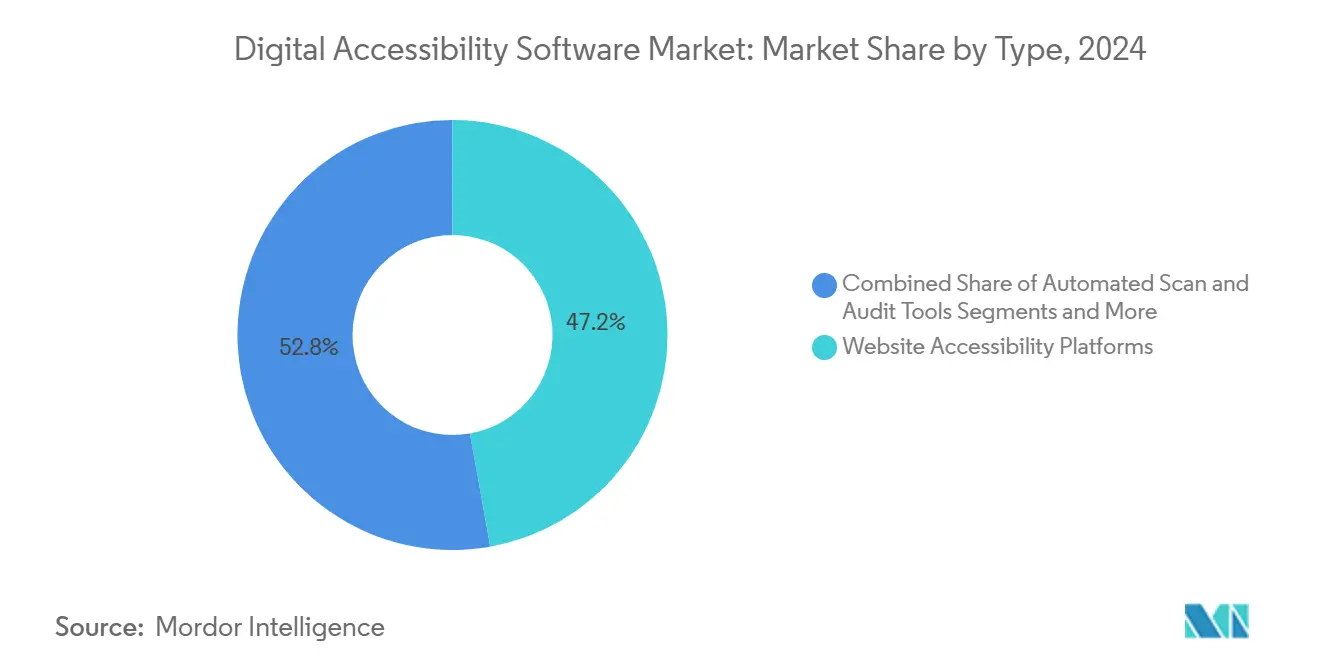
Note: Segment shares of all individual segments available upon report purchase
By Deployment Mode: Cloud Dominance Accelerates
Cloud-based offerings accounted for 54.7% of 2024 revenue and are forecast to rise faster than on-premise alternatives at a 13.90% CAGR. Continuous scanning and real-time dashboards align well with DevOps pipelines, making cloud a default choice for digital teams that ship code weekly. Subscription pricing distributes costs over operating budgets, appealing to finance teams looking to avoid capex spikes. Compliance officers favor vendor-hosted attestation portals that compile Accessibility Conformance Reports instantly, simplifying audits.
On-premise deployment persists in defense, healthcare, and finance where data-residency laws prevail, yet the total cost differential versus SaaS widens each year. Hybrid models emerge as compromise solutions combining local scanning agents with cloud analytics. As customers migrate content workloads to public clouds, demand for in-house scanners declines, reinforcing momentum toward hosted architectures. Vendors responding with FedRAMP or ISO 27001 certifications widen the addressable federal market without sacrificing SaaS advantages. The digital accessibility software market thus leans decisively toward cloud paradigms over the forecast horizon.
By Organization Size: SME Adoption Accelerates
Large enterprises generated 61.8% of 2024 revenue thanks to complex global footprints that require multi-language testing and board-level risk oversight. They sign multi-year contracts bundled with training and managed services, providing predictable recurring revenue to vendors. However, SMEs post a 12.60% CAGR because low-code remediation widgets flatten technical barriers. Pay-as-you-grow subscriptions let retailers or local governments add page-views without license renegotiation.
Open-platform APIs further democratize accessibility by plugging into e-commerce builders and content management systems out-of-the-box. This “accessibility-as-a-service” model allows microbusinesses to embed compliance without hiring specialists, expanding the bottom of the pyramid. As AI reduces scan times from hours to minutes, vendors unlock usage-based pricing that closely aligns fees with site traffic, enhancing adoption. Consequently, SMEs become the growth engine underpinning broader digital accessibility software market expansion.
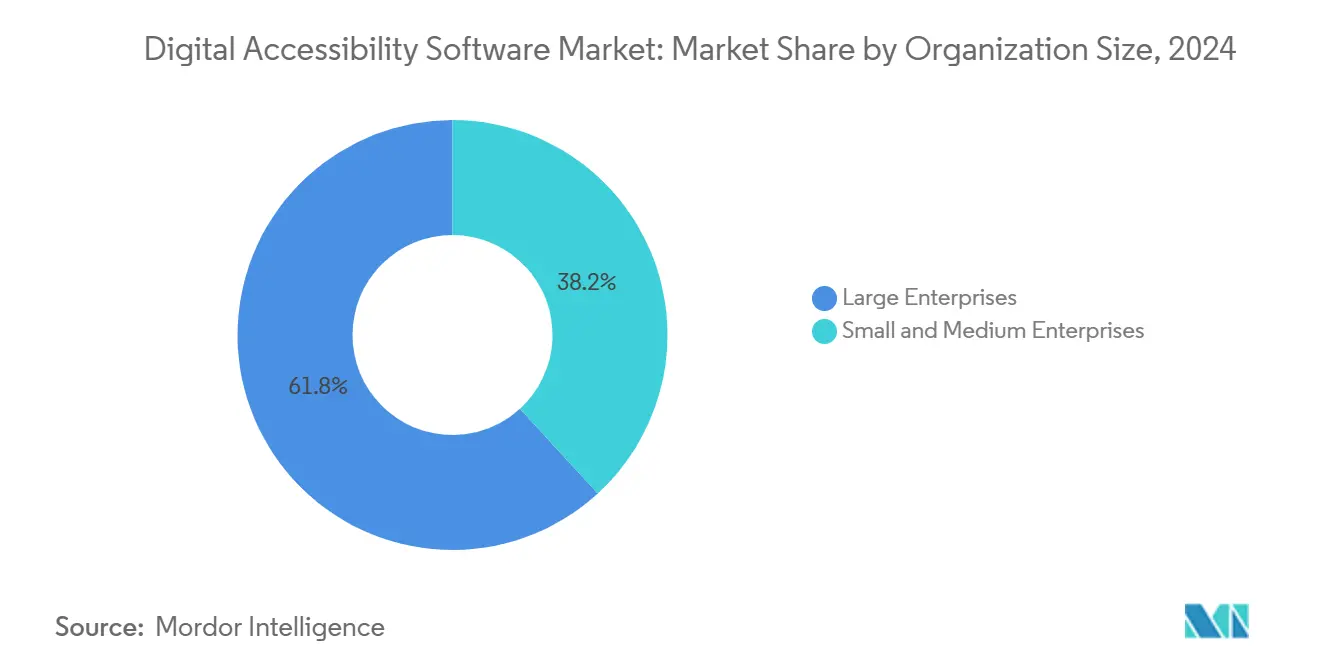
By End-User Industry: Government Leads, Media Accelerates
Public-sector buyers held 29.5% share, reflecting stringent Section 508 procurement clauses that require ACR documentation with every solicitation. Federal and state agencies prioritize vendors offering turnkey remediation across PDFs, intranets, and legacy apps. Their purchasing power influences contractor ecosystems, forcing private suppliers to adopt the same tools. In parallel, Media and Entertainment sits at a 12.20% CAGR as streaming, esports, and live-event platforms push accessible caption pipelines to stay competitive.
BFSI institutions invest in accessible banking portals to attract the USD 490 billion disability community. Barclays’ accessible ATMs and JP Morgan’s in-house training of 200,000 staff illustrate how accessibility extends beyond websites into customer-experience design. Healthcare providers implement patient-portal compliance to mitigate litigation and improve digital equity indices tied to reimbursement models. Retail and e-commerce merchants embed accessibility into storefront themes to capture incremental conversion lift from inclusive design, using the digital accessibility software market as an operational hygiene factor.
Geography Analysis
North America generated 44.98% of 2024 revenue, propelled by ADA litigation, Section 508 audits, and ESG scorecard metrics embedded in Fortune 500 disclosure. High-profile lawsuits push retail, hospitality, and financial giants to adopt continuous-monitoring platforms, sustaining vendor ARR visibility. Canada mirrors this trajectory as the Accessible Canada Act enforces staggered deadlines, reinforcing regional demand for bilingual testing engines.
Europe contributes steady growth driven by the European Accessibility Act’s 2025 commercial-goods deadline and EN 301 549 alignment with WCAG 2.2. Pan-EU harmonization lets multinationals deploy one solution across 27 member states, rewarding vendors with strong localization and data-privacy credentials. Government subsidies for SME compliance in Germany and France expand the mid-tier funnel. The digital accessibility software market capitalizes on fintech and telco pilots that demonstrate ROI through increased customer reach.
Asia-Pacific posts the highest 11.90% CAGR as Japan’s updated guidelines, Australia’s Disability Discrimination Act, and China’s service-accessibility rules converge with explosive mobile-commerce growth. Local language support and right-to-left script handling become differentiators. Vendor partnerships with regional system integrators accelerate penetration, particularly in India’s public-sector digitization wave. Despite fewer lawsuits, corporate brand value and aging demographics spur voluntary adoption. Collectively these developments reinforce the global expansion narrative underlying the digital accessibility software market.
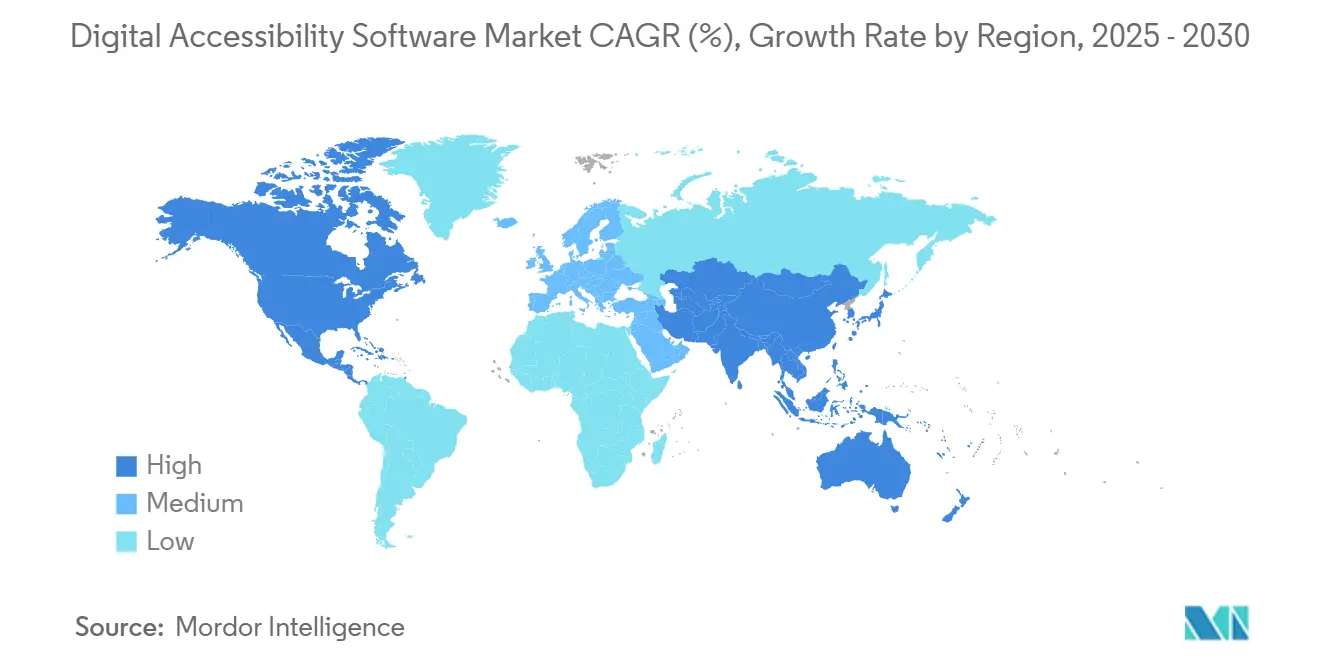
Competitive Landscape
The vendor ecosystem exhibits moderate concentration. Level Access, Siteimprove, and AudioEye anchor the leader quadrant, each exceeding USD 100 million ARR or approaching that threshold. Level Access’s USD 98 million acquisition of UserWay exemplifies roll-up strategies that fuse AI overlays, manual audits, and legal advisory under one brand. Siteimprove differentiates through content-quality analytics layered with accessibility scoring, winning enterprise contracts that favor all-in-one digital-experience suites. AudioEye advances a partner-channel model where resellers and CMS plug-ins drive 60% of ARR, scaling reach without proportionate sales-and-marketing spend.[3]AudioEye Inc., “Form 10-K,” SEC.GOV
AI leadership emerges as the new battleground. Deque Systems licenses its axe-core engine under open-source terms yet monetizes enterprise extensions boasting 90% automated-fix rates, curbing false positives.
Overlay backlash spurs transparency pledges and third-party audits, influencing buying criteria. Capital inflow, such as Eye-Able’s EUR 20 million raise, signals investor confidence in regional challengers targeting EU midsize firms. As acquisitions continue, interoperability standards dictate whether niche innovators survive standalone or integrate into platform suites, shaping future digital accessibility software market structure.
Digital Accessibility Software Industry Leaders
-
Siteimprove
-
UserWay
-
Level Access
-
Monsido
-
Silktide
- *Disclaimer: Major Players sorted in no particular order
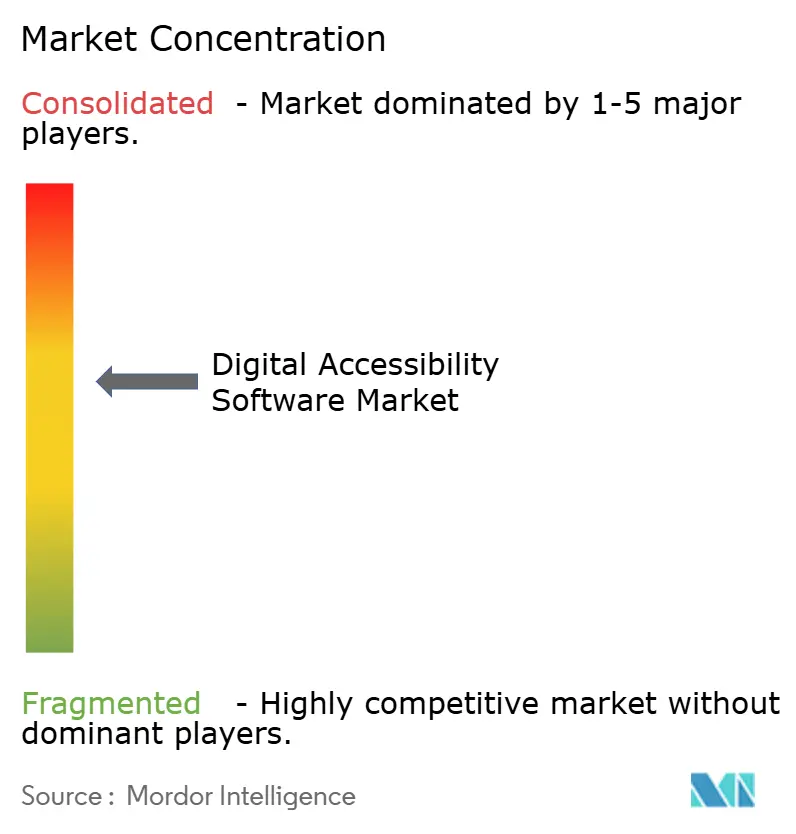
Recent Industry Developments
- February 2025: Deque Systems unveiled axe AI upgrades that elevate automated-fix accuracy and cut false positives.
- January 2025: Netflix extended multilingual audio descriptions, framing accessibility as a competitive streaming feature.
- December 2024: Microsoft refreshed ACRs for Azure, Dynamics 365, and Office 365 in line with EN 301 549, easing enterprise procurement.
- December 2024: Level Access surpassed USD 100 million ARR, underscoring subscription durability in the digital accessibility software industry.
Global Digital Accessibility Software Market Report Scope
Digital accessibility is a process that makes digital products and services such as Mobile Apps, Websites, and other digital tools and technologies accessible to everyone. It is more about delivering users access to information, regardless of their disabilities. In today's digital world, where products and services are becoming digital, there is a need for efficient digital accessibility tools. Organizations that neglect accessibility must understand that they are failing clients and will continue to fail them. Moreover, good usability enhances the digital experience for all users.
The digital accessibility software market is segmented by type (color contrast checker software, website accessibility software), by organization size (small and medium enterprises, large enterprises), by geography (North America, Europe, Asia Pacific, Latin America, Middle East, and Africa). The market sizes and forecasts are provided in terms of value in USD for all the above segments.
| Website Accessibility Platforms |
| Automated Scan and Audit Tools |
| Color-Contrast and Readability Checkers |
| Mobile and App Accessibility Suites |
| Video and Captioning Assist Tools |
| Document and PDF Remediation Software |
| Cloud-Based |
| On-Premise |
| Large Enterprises |
| Small and Medium Enterprises |
| E-commerce and Retail |
| Banking, Financial Services and Insurance (BFSI) |
| Government and Public Sector |
| Healthcare and Life Sciences |
| Education |
| Media and Entertainment |
| North America | United States | |
| Canada | ||
| Mexico | ||
| South America | Brazil | |
| Argentina | ||
| Colombia | ||
| Rest of South America | ||
| Europe | Germany | |
| United Kingdom | ||
| France | ||
| Italy | ||
| Spain | ||
| Russia | ||
| Netherlands | ||
| Rest of Europe | ||
| Asia-Pacific | China | |
| Japan | ||
| South Korea | ||
| India | ||
| Australia | ||
| Singapore | ||
| Rest of Asia-Pacific | ||
| Middle East and Africa | Middle East | Saudi Arabia |
| United Arab Emirates | ||
| Rest of Middle East | ||
| Africa | South Africa | |
| Egypt | ||
| Rest of Africa | ||
| By Type | Website Accessibility Platforms | ||
| Automated Scan and Audit Tools | |||
| Color-Contrast and Readability Checkers | |||
| Mobile and App Accessibility Suites | |||
| Video and Captioning Assist Tools | |||
| Document and PDF Remediation Software | |||
| By Deployment Mode | Cloud-Based | ||
| On-Premise | |||
| By Organization Size | Large Enterprises | ||
| Small and Medium Enterprises | |||
| By End-User Industry | E-commerce and Retail | ||
| Banking, Financial Services and Insurance (BFSI) | |||
| Government and Public Sector | |||
| Healthcare and Life Sciences | |||
| Education | |||
| Media and Entertainment | |||
| By Geography | North America | United States | |
| Canada | |||
| Mexico | |||
| South America | Brazil | ||
| Argentina | |||
| Colombia | |||
| Rest of South America | |||
| Europe | Germany | ||
| United Kingdom | |||
| France | |||
| Italy | |||
| Spain | |||
| Russia | |||
| Netherlands | |||
| Rest of Europe | |||
| Asia-Pacific | China | ||
| Japan | |||
| South Korea | |||
| India | |||
| Australia | |||
| Singapore | |||
| Rest of Asia-Pacific | |||
| Middle East and Africa | Middle East | Saudi Arabia | |
| United Arab Emirates | |||
| Rest of Middle East | |||
| Africa | South Africa | ||
| Egypt | |||
| Rest of Africa | |||
Key Questions Answered in the Report
What is the current value of the digital accessibility software market?
The market is valued at USD 0.80 billion in 2025.
How fast is the sector expected to grow through 2030?
It is forecast to expand at a 6.31% CAGR, reaching USD 1.08 billion by 2030.
Which deployment model is growing the quickest?
Cloud-based solutions post a 13.90% CAGR owing to real-time scanning and subscription pricing.
Which region shows the strongest future upside?
Asia-Pacific leads with an 11.90% CAGR, fueled by emerging regulations and rapid digitization.
Why are SMEs adopting accessibility platforms now?
Low-code SaaS tools cut technical barriers and align fees with usage, enabling affordable compliance.
What technology shift is most improving remediation accuracy?
AI models that surpass 90% accuracy are reducing false positives and automating alt-text creation.
Page last updated on:
